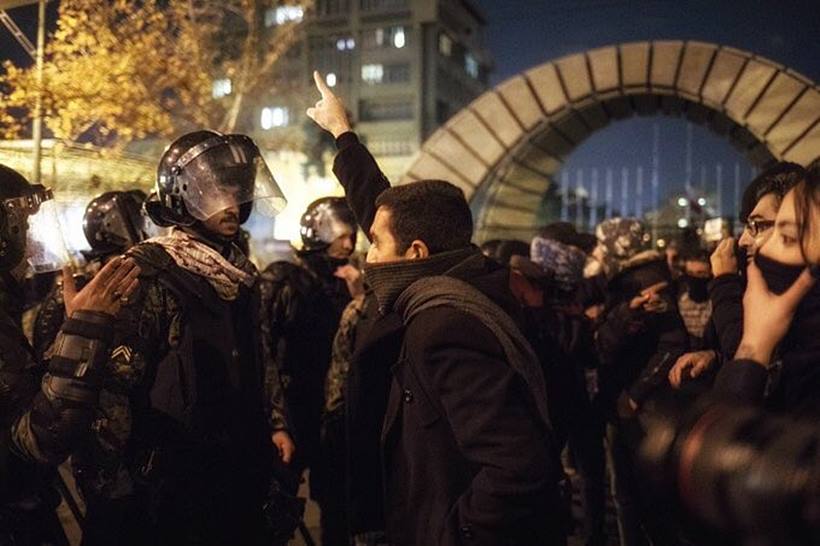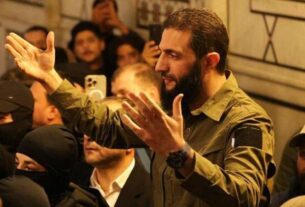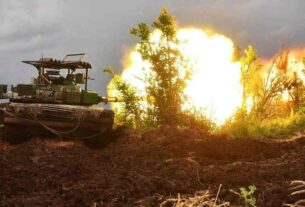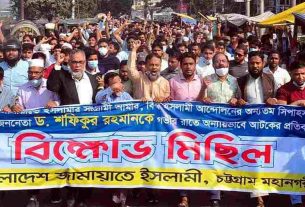Thu 16 January 2020:
Verified video footage, photographs and testimonies from victims and eyewitnesses on the ground obtained by Amnesty International confirm that Iranian security forces used unlawful force against peaceful protesters who gathered across Iran following the authorities’ admission that they had shot down a Ukrainian passenger plane on 8 January.
The evidence indicates that on 11 and 12 January security forces fired pointed pellets from airguns, usually used for hunting, at peaceful protesters causing bleeding and painful injuries. Security forces also used rubber bullets, tear gas and pepper spray to disperse protesters as well as kicking and punching them, beating them with batons and carrying out arbitrary arrests.
“It is appalling that Iran’s security forces have violently crushed peaceful vigils and protests by people demanding justice for the 176 passengers killed on the plane and expressing their anger at the Iranian authorities’ initial cover-up,” said Philip Luther, Research and Advocacy Director for the Middle East and North Africa at Amnesty International.
“The use of unlawful force in the latest demonstrations is part of a long-standing pattern by Iranian security forces.”
The use of unlawful force in the latest demonstrations is part of a long-standing pattern by Iranian security forces
Unlawful use of force
Testimonies and photographs obtained by Amnesty International indicate that security forces fired pointed pellets, causing painful wounds and requiring surgical treatment to remove the pellets, as well as injuries consistent with rubber bullet use. Such pellets are used for hunting small game and are completely inappropriate for use in any policing situation.
The organization’s Digital Verification Corps also verified dozens of videos showing security forces firing tear gas into crowds of peaceful protesters.
Security forces deployed on the streets, included the special forces of Iran’s police, paramilitary Basij and plain-clothes agents.
One of the videos verified by Amnesty International shows two women in Tehran lying injured and bleeding on the ground. In another video recorded nearby, a woman is seen lying on the ground in a pool of blood crying out in pain. The people helping them in the videos are heard saying they have been shot. Amnesty International has not been able to establish what type of ammunition was used to cause these injuries.
Another video shows a man with a bleeding head wound. Two X-rays obtained by Amnesty International clearly show pellets lodged in the knee joint of one protester and the ankle of another.
Amnesty International has also verified images of security forces carrying shotguns, but it is unclear what type of ammunition was loaded in them.
The organization has received messages from several injured protesters who shared photographs showing their wounds and said they did not seek hospital treatment to remove the pointed pellets that remain painfully lodged in their bodies, fearing arrest.
Security and intelligence forces are maintaining a heavy presence in some hospitals raising fears they plan to arrest patients. Amnesty International has also received information that security forces have tried to transfer some injured protesters to military hospitals. Some medical clinics and hospitals in Tehran have turned away injured people, telling them that, if the security and intelligence forces find out they were among the protesters, they will be arrested.
One man from Maali Abad in Shiraz, Fars province, who said he went to light a candle in solidarity with the plane crash victims on 12 January, said security forces outnumbered the crowd and created a “terrifying and intimidating atmosphere to frighten people away”.
“They were swearing at and beating everyone with batons all over their bodies, it didn’t matter if they were just passing by. It didn’t make any difference to them if they beat young or old, man or woman,” he said, adding that security forces also fired tear gas into the crowd. He was injured but did not seek hospital treatment for fear of arrest.
Another eyewitness, Mahsa from Tehran, described how security forces fired tear gas into the entrance hall of a metro station to stop people leaving to join the protest.
There was so much tear gas… I was so mentally stressed and anxious that I initially didn’t even realize that I had been shot
“There was so much tear gas… I was so mentally stressed and anxious that I initially didn’t even realize that I had been shot… The special forces of the police were firing pointed pellets at people. My coat is now filled with holes and I have bruises on my body… The streets were filled with armed plain-clothes agents firing shots into the air and threating to shoot people… A member of the security forces chased me when they saw me filming the protest and that’s when I was shot in the leg with a pointed pellet… I’m in a lot of pain,” she said.
Mahsa added that the authorities had threatened doctors and that she had been turned away by three medical centres and even a veterinary clinic where she sought treatment. On 14 January, she was told by a doctor in a hospital in Tehran that she had to leave the hospital immediately because, if the intelligence department (Herasat) of the hospital found out that she was among the protesters, she would be arrested.
“The situation in Iran right now is even more painful than death. They are killing us slowly; they are torturing us to death,” she said.
In several videos taken inside Shademan metro station in Tehran, people are heard saying that security forces fired tear gas inside the station. Tear gas canisters are indiscriminate and can result in serious injury and even death, especially when used in an enclosed space. They should only ever be used in a targeted response to specific acts of violence and never to disperse peaceful protesters. They must also never be used in a confined space.
In many cases the actions by the security forces violated the absolute prohibition of torture and other ill-treatment under international law.
Arbitrary arrests
There are reports that scores of people, including university students, have been arrested in cities where protests have taken place, including Ahvaz in Khuzestan province; Esfahan, Esfahan province, Zanjan, Zanjan province; Amol and Babol, Mazandaran province; Bandar Abbas, Hormozgan province; Kermanshah, Kermanshah province; Sanandaj, Kurdistan province; Mashhad, Razavi Khorasan province; Shiraz, Fars province; Tabriz, East Azerbaijan province; and Tehran.
Amnesty International has received information that, in at least two cities, Amol and Tehran, the authorities are denying the families of some detainees information about their fate and whereabouts, amounting to the crime of enforced disappearance under international law.
The organization also received shocking allegations of sexual violence against at least one woman arbitrarily arrested by plain-clothes security agents and detained for several hours in a police station. According to an informed source, while in detention, the woman was taken to a room where she was questioned by a security official who forced her to perform oral sex on him and attempted to rape her.
Iran’s security forces have once again carried out a reprehensible attack on the rights of Iranian people to peaceful expression and assembly and resorted to unlawful and brutal tactics
“Iran’s security forces have once again carried out a reprehensible attack on the rights of Iranian people to peaceful expression and assembly and resorted to unlawful and brutal tactics,” said Philip Luther.
“The Iranian authorities must end the repression as a matter of urgency and ensure the security forces exercise maximum restraint and respect protesters’ rights to peaceful expression and assembly. Detainees must be protected from torture and other ill-treatment and all those who have been arbitrarily detained must be released.”
Background
The protests began on 11 January after the Iranian authorities admitted to having unintentionally shot down the Ukrainian plane, following three days of denials, at first attributing the plane crash to mechanical failure. The protests quickly expanded to include anti-establishment slogans and demands for transformation of the country’s political system, including a constitutional referendum and an end to the Islamic Republic system.
These protests follow a bloody crackdown that saw more than 300 protesters killed and thousands arrested between 15 and 18 November 2019 when Iranian security forces resorted to lethal force. Amnesty International has called on member states of the UN Human Rights Council to hold a special session on Iran to mandate an inquiry into the unlawful killings of protesters, horrifying wave of arrests, enforced disappearances and torture of detainees, with a view to ensuring accountability.
-amnesty.org
Think your friends would be interested? Share this story!





